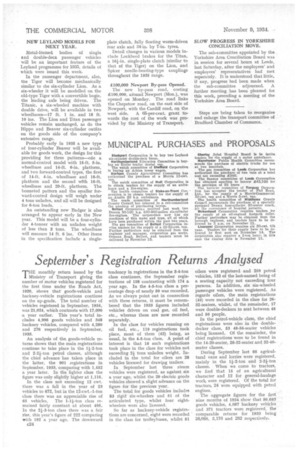September's Registration Returns Analysed
Page 54

If you've noticed an error in this article please click here to report it so we can fix it.
THE monthly return issued by the Ministry of Transport giving the number of motor vehicles registered for the first time under the Roads Act, 1920, shows that goods-vehicle and hackney-vehicle registrations continue on the up-grade. The total number of vehicles registered in September, 1934, was 21,024, which contrasts with 17,090 a year earlier. This year's total includes 4,996 goods vehicles and 348 hackney vehicles, compared with 4,280 and 276 respectively in September, 1933.
An analysis of -the, goods-vehicle returns shows that the main registrations continue to take place in the 11-2-ton and 2-2i-ton petrol classes, although the chief advance has taken place in the latter, the 901 registrations in September, 1933, comparing with 1,452 a year later. In the lighter class the figure was only slightly higher at 1,116.
In the class not exceeding 12 cwt. there was a fall in the year of 23 vehicles to 672, but in the 12-cwt.-1-ton class there was an appreciable rise of
65 vehicles. The 1-11-ton class remained fairly constant at about 495. In the 21-3-ton class there was a fair rise, this year's figure of 222 comparing with 192 a year ago. The downward
c24 tendency in registrations in the 3-4-ton class continues, the September registrations of 158 contrasting with 174 a year ago. In the 4-5-ton class a percentage drop of nearly 50 was recorded. As we always point out in connection with these returns, it must be remembered that the 1933 figures included vehicles driven on coal gas, oil fuel, etc., whereas these are now recorded separately.
In the class for vehicles running on oil fuel, etc., 119 registrations took place, most of them (42) being, as usual, in the 4-5-ton class. A point of Interest is that 18 such registrations took place in the class for vehicles not exceeding 21 tons unladen weight. Included in the total for oilers are 28 vehicles licensed for drawing trailers.
In September last three steam vehicles were registered, as against six a year ago, whilst the 20 electric goods vehicles showed a slight advance on the figure for the previous year.
The total for goods vehicles includes 83 rigid six-wheelers and 51 of the articulated type, whilst four eightwheelers were also licensed.
So far as hackney-vehicle registrations are concerned, eight were recorded in the class for trolleybuses, whilst 81
oilers were registered and 259 petrol vehicles, 132 of the last-named being of a seating capacity not exceeding four persons. In addition, six six-wheeled passenger vehicles were registered. As regards oilers, the main registrations (49) were recorded in the class for 2632-seaters, whilst, of the remainder, 17 were double-deckers to seat between 48 and 5(3 people.
In the petrol-vehicle class, the chief registrations were also in the doubledecker class, 53 48-56-seater vehicles being licensed. Of the remainder, the chief registrations were to be found in the 14-20-seater, 26-32-seater and 32-40seater classes.
During September last 66 agricultural vans and lorries were registered, mainly in the 11-2-ton and 2-21-ton classes. When we come to tractors, we find that 15 of an agricultural character and 12 for general-haulage work. were registered. Of the total for tractors, 24 were equipped with petrol engines.
The aggregate figures for the first nine months of 1934 show that 50,693 goods vehicles, 4,087 hackney vehicles and 371 tractors were registered, the comparable returns for 1933 being 38,088, 3,176 and 282 respectively.
























































































































